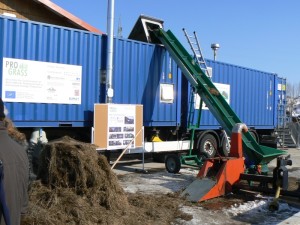 Conrad is blue, large and takes a Mercedes lorry to pull him (him, her, it) and was specifically constructed to investigate the viability of using different kinds of crops (semi-natural grasslands, road side verges, rushes, bracken, gorse) which are often perceived as problem habitats. The aim is to find
Conrad is blue, large and takes a Mercedes lorry to pull him (him, her, it) and was specifically constructed to investigate the viability of using different kinds of crops (semi-natural grasslands, road side verges, rushes, bracken, gorse) which are often perceived as problem habitats. The aim is to find out whether these crops can be used to manufacture what will be viable biomass fuel with a multitude of economic, environ-mental and social benefits – three pillars of sustainable development.
out whether these crops can be used to manufacture what will be viable biomass fuel with a multitude of economic, environ-mental and social benefits – three pillars of sustainable development.
First test runs in the partners regions of the COMBINE project have been carried out. In November blue Conrad was moved to Wales, UK, where open days were organised at Hafod y Llan.
During these demonstration events experts took a look at the transportable IFBB plant. An adapted version of this could be used by cooperatives of farmers in future. Inside its blue box exterior, the double lorry-sized scheme washes problematic mineral content from material before pressing it for use as fuel. This unique pre-treatment process means that carbon emissions and ash content are reduced.
Andy Bull, Head of Regional Strategy and Planning at Severn Wye Energy Agency and partner in the COMBINE project said: “In the past few years we’ve seen a decrease of agricultural activities, such as grazing, across Europe. Over time this could lead to a decline in our open landscapes and biodiversity, as these areas become dominated by shrub and woodland vegetation.
“The new technology we’re now trialling could help to prevent this problem, and while doing so also create more efficient energy supply chains. We hope it will resolve the conflict between bio-energy and food production by utilising raw materials which have previously not been suitable for biomass, such as roadside verges.”

